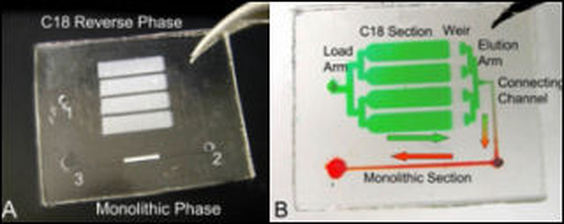Microfluidic-based Nucleic Acid Purification in a Two-Stage, Dual-Phase Microchip
The need for high DNA binding capacity is important in many clinical applications that rely on whole blood as a source of genomic DNA. Lysed whole blood contains nucleic acids, proteins, lipids, metabolites, and inorganic ions, some of which are known to inhibit PCR, a technique used in almost all genetic analyses. However, the proteins in blood also bind to the solid phase limiting the DNA binding capacity. To solve this problem, a two-stage, dual phase microdevice for DNA extraction from whole blood has been developed. This device captures proteins using an in-line C18 phase, allowing the DNA to bind to the DNA extraction phase with significantly decreased protein competition. Successful PCR amplification following purification of DNA from human whole blood illustrated the effectiveness of the method. An added benefit of this method is the ability to remove the protein wash step normally required to remove proteins from the DNA extraction phase; this accelerates the analytical process, reduces the number of steps and eliminates potential sample contamination that may occur from switching syringes or tubing. With the majority of the extracted DNA released in a small volume, this system is ideal for concentrating and purifying DNA from whole blood on integrated microfluidic devices.
|
Contact Landers Research Group
jpl5e@virginia.edu (434) 243-8658 375, 379, 395 Chemistry Building McCormick Road Charlottesville, Va 22904 |


